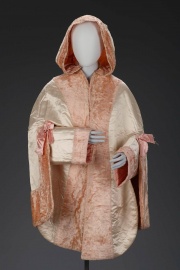Difference between revisions of "Satin weave"
Jump to navigation
Jump to search
(username removed) |
(username removed) |
||
| Line 2: | Line 2: | ||
== Description == | == Description == | ||
| − | One of three fundamental fabric weaving patterns: [http://cameo.mfa.org/materials/fullrecord.asp?name=plain | + | One of three fundamental fabric weaving patterns: [http://cameo.mfa.org/materials/fullrecord.asp?name=plain%20weave plain], satin, and [http://cameo.mfa.org/materials/fullrecord.asp?name=twill%20weave twill]. Satin weave is made by passing filling yarns over 1 warp yarn then under 4-12 warp yarns. The long filling threads, called floats, produce a smooth shiny surface, but are susceptible to snags. Examples of satin weave fabrics are [http://cameo.mfa.org/materials/fullrecord.asp?name=satin satin], Venetian cloth, and messaline. |
| − | See also [http://cameo.mfa.org/materials/fullrecord.asp?name=sateen | + | See also [http://cameo.mfa.org/materials/fullrecord.asp?name=sateen%20weave sateen weave]. |
== Additional Images == | == Additional Images == | ||
| Line 16: | Line 16: | ||
== Authority == | == Authority == | ||
| − | * | + | * Hoechst Celanese Corporation, ''Dictionary of Fiber & Textile Technology'' (older version called Man-made Fiber and Textile Dictionary, 1965), Hoechst Celanese Corporation, Charlotte NC, 1990 |
| − | * | + | * Rosalie Rosso King, ''Textile Identification, Conservation, and Preservation'', Noyes Publications, Park Ridge, NJ, 1985 |
| − | * | + | * Edward Reich, Carlton J. Siegler, ''Consumer Goods: How to Know and Use Them'', American Book Company, New York City, 1937 |
| − | * | + | * Hermann Kuhn, ''Conservation and Restoration of Works of Art and Antiquities'', Butterworths, London, 1986 |
* Art and Architecture Thesaurus Online, http://www.getty.edu/research/tools/vocabulary/aat/, J. Paul Getty Trust, Los Angeles, 2000 | * Art and Architecture Thesaurus Online, http://www.getty.edu/research/tools/vocabulary/aat/, J. Paul Getty Trust, Los Angeles, 2000 | ||
Revision as of 07:33, 24 July 2013
Description
One of three fundamental fabric weaving patterns: plain, satin, and twill. Satin weave is made by passing filling yarns over 1 warp yarn then under 4-12 warp yarns. The long filling threads, called floats, produce a smooth shiny surface, but are susceptible to snags. Examples of satin weave fabrics are satin, Venetian cloth, and messaline.
See also sateen weave.
Additional Images
Authority
- Hoechst Celanese Corporation, Dictionary of Fiber & Textile Technology (older version called Man-made Fiber and Textile Dictionary, 1965), Hoechst Celanese Corporation, Charlotte NC, 1990
- Rosalie Rosso King, Textile Identification, Conservation, and Preservation, Noyes Publications, Park Ridge, NJ, 1985
- Edward Reich, Carlton J. Siegler, Consumer Goods: How to Know and Use Them, American Book Company, New York City, 1937
- Hermann Kuhn, Conservation and Restoration of Works of Art and Antiquities, Butterworths, London, 1986
- Art and Architecture Thesaurus Online, http://www.getty.edu/research/tools/vocabulary/aat/, J. Paul Getty Trust, Los Angeles, 2000


